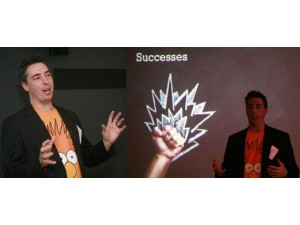Johannesburg, 16 Nov 2012

August this year saw the 5th edition of the South African Innovation Summit in Johannesburg, where a number of South Africa's most innovative minds came to discuss just this - innovation and South Africa's competitive edge. Saratoga's Head of Innovation, Jason Haddock, was there and shared his own wisdom of nurturing a culture of innovation within a South African business context.
Taking care of business
Switzerland has been identified as the world's leader in innovation for a second year in a row, but South Africa was rated only 54 (with not one single sub-Saharan country making it into the top 50). While developing economies are less likely to be found in the top slots, it's good to look at Switzerland to see what makes it the leader in innovation. Quality of the countries scientific research is credited with its success, but also, good connections between academia and firms help to create a skilled labour force. But how does South Africa compare?
Haddock noted that there was an increase in commitment from South African academic institutions, with some presentations showcasing what innovative work is being done by their students. Education is only one aspect expanding innovation, but he believes that building sustainable innovation into the very fabric of company cultures will be the answer for local businesses.
Seeds of innovation
His recipe for success is something he put into practice within Saratoga and he believes this approach has had an immense impact on the way it does business and meets client needs - design thinking. Haddock claims this is the key to unlocking innovation if it is integrated with other organisational frameworks. "Almost all innovations today," Haddock says, "will be used at some stage by a person, and this is why I believe design thinking is such a great framework as it puts the person squarely at the centre."
His thinking is in line with others at the Innovation Summit, as design thinking was one of the meta themes of the conference, with a number of speakers either directly discussing the subject or using core components of design thinking in their talks. "It is great to see the growth of systems and design thinking in South Africa. I believe that if more companies and individuals embrace these concepts, we can collectively unlock Africa's competitive edge," says Haddock.
Design thinking is a relatively new concept that seeks to combine the benefits of both an analytical and a creative approach to problem solving. It is also the idea of taking design beyond the way objects are made and instead looking at the greater issues at hand. This kind of approach is credited to finding a result or solution that is both innovative and offers deeper impact than the "easy" or obvious solution.
Inspiring innovators
The innovation lab at the summit showcased some of the South African start-ups and innovators who were truly a sight to behold. Haddock felt it was very humbling to see how many innovative minds we have in this country and the ground-breaking ideas they are coming up with. His belief is that South African business undoubtedly has the ability to unlock more innovations but that this needs to be supported through funding, mentoring and encouragement.
The SA Innovation Summit should be an essential part of annual conference attendance for anyone who has an interest in business, technology or innovation. The Summit itself is a perfect example of the ability of South Africans to put on an event of world-class standard, from start to finish - upfront cappuccino conversations with Nico Steyn, like this one with Jason Haddock, to workshops and the main conference itself, were a non-stop wealth of information and inspiration from business innovation through to better understanding of cognitive behaviour.
See you next year!
* Author: Sarah Meder, Saratoga staff writer